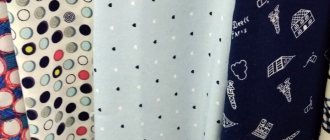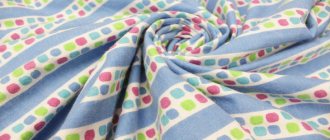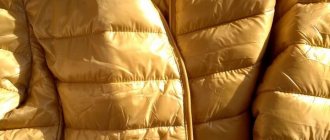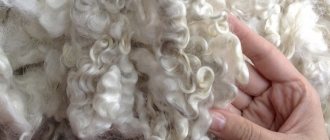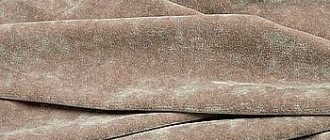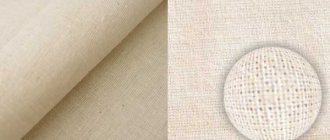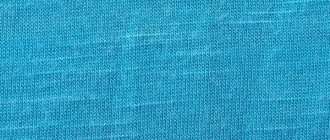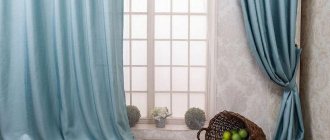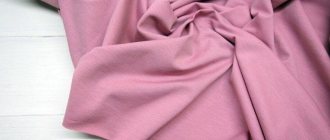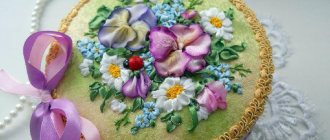What kind of fabric
So what is dralon? Dralon is a strong, heat-resistant acrylic fiber that can be found in many types of yarn.
Polyacrylonitrile fiber is obtained from acrylonitrile, as well as its copolymers. The process of producing dralon from acrylic fiber occurs using the polymerization method.
Initially, dralon goes through a molding stage, after which the fibers are drawn out on a spinning machine. After this, they are washed from the solvent and painted. Next, the dralon is dried to fix the coloring matter. To increase the thermal properties of the fibers, resistance to abrasion and deformation, heat treatment is carried out. Also, their interaction with heat allows for less shrinkage.
Characteristics of dralon fabric
The material was developed with improved performance characteristics, thanks to which there are many good qualities among its parameters:
- air permeability. The material has excellent breathability; hypoallergenic.
- Dralonne is considered an allergen and does not irritate the skin; resistance to deformation.
- Does not stretch, does not shrink, does not change its original shape; antibacterial. Dust mites, mold fungi, moths, and harmful bacteria do not multiply in it; resistance to the influence of acid even at strong concentrations; resistance to slightly alkaline solutions; resistance to organic solvents (acetone, gasoline); very high wear resistance; fortress;
- ability to thermoregulate. Dralon
retains the heat
well and according to these properties it is close to real wool; dirt resistance; resistance to mechanical influences; no susceptibility to the accumulation of electricity resulting from friction; tactile characteristics - the material is soft, pleasant to the touch; resistance to sunlight - under the influence of ultraviolet rays, the fibers do not deteriorate and the colors do not fade; ease of care.
At the same time, the material collapses under the influence of phenol and formaldehyde.
Compound
Dralon is based on acrylic, which makes it stable. Additional properties of “strength” are provided by threads that have similar qualities. Due to the use of threads of different colors, the fabric has unsurpassed color fastness and brightness.
Typically, this fabric consists of 70% synthetic polyacrylonitrile fiber. The remaining 30% includes various natural or synthetic fibers.
Depending on the methods of making fabrics, you can get completely different materials: orlon, acrylan, cashmilon, kurtel, volprulla. Of course, their chemical and physical properties are different. It is difficult to buy exactly dralon in stores, since it is often called “nitron”.
Raw materials and production
Dralon is a material made from very durable heat-resistant acrylic fiber.
The developer and manufacturer of the dralon is considered to be. Dralon is a trade name; in a wide variety of countries, analogues have different names: in our country it is nitron, in America - orlon, in the land of the rising sun - cashmilon, etc.
Dralon acrylic fibers are produced by spinning from polyacrylonitrile solutions.
During the manufacture of fabric, warp and weft threads are often used in a variety of colors, which determines the special stability of the colors and the brightness of the colors.
Types and their properties
Dralon fabric, depending on the fibers included in it, has different characteristics and features. In fact, dralon fabric was designed with a focus on quality performance.
Varieties of dralon yarn:
- produce pure 100% dralon “NEON FINE”, which has about 10 colors. But many factories do not limit themselves to producing 100% dralon. They produce other blended fabrics containing linen, wool or cotton, for example;
- for example, “Boom fine” yarn, which contains 50% wool and 50% dralon. Due to the inclusion of dralon (acrylic fibers), items made from this yarn are soft, hold their shape well and retain heat;
- There is another type of yarn, which contains 51% merino wool and 49% dralon - this is “BOOM FINE” wool blend.
The more flax in the structure, for example, the more similar the material is to natural fabric. As a rule, such fabrics are used not only for the interior of the house (upholstery), but also on the streets.
Advantages
Dralon has advantageous characteristics for the consumer: the fabric is resistant to abrasions and is easy to care for (contamination is easily removed).
- It is resistant to thermal influences and practically does not lose color (brightness).
- Not electrified.
- Due to Teflon impregnation, the fabric is endowed with “immunity” to water, grease and other dirt.
- Dralon is resistant to solvents with an organic composition (acetone, gasoline), weak alkalis, certain groups of acids (highly concentrated) and mechanical damage (does not stretch much, does not shrink, does not wrinkle);
- Hypoallergenic;
- Antibacterial (there are no living conditions for mites, fungi, moths and other microorganisms);
- Wear-resistant and durable;
- The material is practically not destroyed during operation.
What it is?
Dralon is a chemically produced synthetic fabric. The material is distinguished by high density, pleasant texture and a variety of shades. Despite the monotony of such paintings, they look very decent.
Manufacturing Features
The technology for producing this material was developed by the German company Bayer Textilfaser. Hydrocarbon raw materials are taken as the basis. Strong heating and simultaneous chemical treatment make it possible to create thin but very strong acrylic threads. The resulting fibers are dyed and dried. They are then woven together using a loom. To improve the quality of the canvas, it is reheated and impregnated with a special Teflon compound.
This treatment increases the strength, wear resistance and resistance of the fabric to moisture and dirt.
Pros and cons of the material
Since the development of the technology was aimed at obtaining fabric with improved characteristics, it has many advantages:
- pleasant to the touch texture and hypoallergenic (the likelihood of skin irritation upon contact with the fabric is minimized);
- breathability and antibacterial properties (the material does not encourage the growth of dust mites, molds, moths, etc.);
- lack of tendency to deformation and deterioration of appearance (the fabric does not shrink when washed, does not stretch due to mechanical stress, does not fade in the sun);
- resistance to water, acids, slightly alkaline solutions, organic solvents and household pollution;
- thermoregulation (the ability to retain heat in the human body without accumulating static electricity).
The material has few disadvantages:
- high price;
- destruction upon contact with phenol and formaldehyde;
- the need for regular cleaning (the soft texture tends to attract and accumulate dust, which must be removed periodically).
Application area
Acrylic fibers are widely used to create blended fabrics. Thread is present in many household items, for example: swings, curtains, textile bedspreads, knitted blankets, decorative pillowcases.
Today, knitting yarn with the addition of dralon is in great demand, as it has proven itself well in the market. Products made from this yarn are of no less interest to girls. For example, a dress (item 3522). It contains 50% wool, 50% dralon. Jumpers with a similar composition – 50% wool, 50% dralon – are highly popular.
In fact, dralon is not a “capricious” material, which is why it is often used for the production of furniture (upholstery). Products with such upholstery are resistant to damage, are easy to clean and do not lose color.
Due to the softness of the products and the absence of fluff on them, acrylic yarn is used for knitting children's clothes. In addition to clothes and blankets for babies, toys are knitted from this yarn.
Dralon is also used to make blankets and rugs. For example, a tweed dress or jumper. This material is exquisite, easy to care for, does not wrinkle, and has many other advantages.
What kind of yarn is dralon?
Artificial fibers are fibers obtained by synthesizing polymer materials that consist of natural low-molecular substances (C, H, O, N, etc.) as a result of a polymerization or polycondensation reaction. Polymer materials are synthesized from petroleum products, gas and coal (benzene, phenol, ethene, acetylene, ammonia, hydrocyanic acid), which are produced in large quantities at chemical plants.
By changing the composition of the initial products, it is possible to vary the structure and properties of artificial polymer materials and fibers purchased from them. The most popular among them are: polyamide, polypropylene, polyester and polyurethane. Acrylic
- a synthetic fiber, in many ways close to wool (although there are cotton-like variations), resistant to light and other atmospheric agents, acids, weak alkalis, and organic-based solvents. Acrylic fibers can be dyed well, they are nice and warm, and are not susceptible to being eaten by moths.
Broadcast recording - Carded yarn: what is it?
Acrylic has high shrinkage, which is why it is used to produce high-volume yarn. The disadvantages include abrasion, pillability (albeit less than wool), electrification, allergenicity, low air permeability, loss of dimensional stability.
A considerable part of the disadvantages of initial acrylic can be reduced with special impregnations. Key trade names: nitron (produced in the Soviet Union), orlon, acrylan (USA), cashmilon (Japan), dralon (Germany), curtel (Britain). Dralon
- acrylic fiber, ultra-strong and resistant to various influences.
Yarn
containing dralon is soft, shape-resistant, retains heat, is easy to wash, and dries very quickly.
Nitron
is a type of acrylic fiber, which in its appearance, softness, volume and thermal conductivity is close to wool fiber. Nitron has fairly high strength, elasticity, and thermal stability.
It is resistant to mineral acids and alkalis. Compared to other real and chemical fibers, it has the greatest resistance to light.
The disadvantages of nitron include low hygroscopicity, poor paintability and low wear resistance.
Nitron is used for the production of knitwear, fake fur, and in blended yarns with wool, viscose and other fibers - for the production of fabrics. Polyamide
— characterized by high tensile strength and excellent wear resistance. Resistant to the action of many chemical reagents, resists chemical influences well, and can be painted with many dyes.
It has high dimensional stability, does not lose its shape during wet and dry use, and does not require special care.
Disadvantages - high electrification, instability to the influence of light, low hygienic properties. Key trade names: nylon (Russian Federation), dederon, perlon (Germany), silone (Czech Republic), stilon (Poland), nylon, tactel (USA), lilion (Italy). Nylon is a strong polyamide fiber, which in its strength is second only to flax fibers. The fiber is very elastic and resistant to alkalis.
The disadvantages are low hygroscopicity (although this determines the large use of nylon during the manufacture of raincoats), low heat resistance, low resistance to light, pillability and electrification. Tactel
— very high-quality polyamide fiber, which provides the product with very high comfort, wear resistance, and peeling resistance.
Yarn with the inclusion of tactel is soft, breathable, does not electrify, dries very quickly, and is undemanding in care. Nylon
is another very strong polyamide fiber, used in various types of yarn to increase strength, wear resistance, and reduce shrinkage after washing. It is used for the manufacture of products that require strength and reliability in operation: sportswear, swimwear, lingerie, hosiery.
Now nylon is very often used in the manufacture of yarn: adding nylon to mohair, wool or acrylic in an amount of only 10–15% does not at all impair the hygienic properties of real fibers, but significantly increases their ductility, strength and resistance to deformation. Polyester
- synthetic fiber from the polyester group. From the very beginning, polyester had many disadvantages: despite its exceptional strength, it was rigid, highly electrified, and low hygroscopic.
Currently, polyester for the textile industry is produced in the form of microfibers.
BOBBIN and HINK yarn. HONESTLY all “+” and “-“.
Care
This material is completely unpretentious in care. As mentioned earlier, the fabric is resistant to various stains. In order to remove a minor stain, you just need to wipe it with a damp cloth.
In order for a dralon item to last as long as possible, you should follow some simple rules indicated on the label:
- The product with the addition of dralon can be washed both by hand and by machine wash.
- The maximum washing temperature is 30 degrees.
- You can squeeze it not only with your hands, but also in a washing machine.
- It is recommended to dry dralon items without using mechanical influences. That is, the product must be dried in natural conditions.
- Only items made from the above material should be loaded into the drum of the machine. Other products must be downloaded separately.
- You can resort to dry cleaning services.
- If an item is dirty and it is not possible to remove it (a chair or sofa cover), you should first vacuum it and then wipe it with a slightly damp cloth.
- To remove individual stains, you can resort to the following method: moisten a cotton pad in warm water and, starting from the edges to the center, use gentle movements to reduce the stain to a minimum size.
- The fabric should only be ironed through a protective coating or damp gauze. In this case, the iron setting must be set to “nylon”.
If you follow these simple recommendations, then a product made from dralon can serve for many years in a row.
Dear readers of the Tkan.Club website, if you still have questions on this topic, we will be happy to answer them. Leave your reviews, comments, share stories if you have dealt with this fabric! Your life experience may be useful to other readers.
